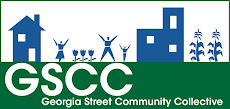
DETROIT
Megan Kohn was watering the neighborhood garden in Romanowski Park when 8-year-old Saba and her friend Alea came by to see what was going on.
After the girls asked to help, Megan directed them to get trowels out of her red truck parked 11 raised garden beds away.
As the trio cleared a bed for planting seedlings, Saba said, “I love gardening, It’s cool. It’s nice. And you can get your hands dirty without getting yelled at. You get to plant things and when they grow, you pick them.”
Such interaction between kids and adults is one reason that Ms. Kohn, an urban agriculture apprentice for the Greening of Detroit (www.greeningofdetroit.com), is encouraging families in the neighborhood to come to the garden to work, visit, and harvest fresh produce.
Another reason is that she and others see such urban gardens – 355 of them so far, planted throughout the 139-square-mile city – as vital to the revitalization of Detroit, often called a rusted out industrial city.
“Food is essential to daily life,” says Ashley Atkinson, director of urban agriculture for the Greening of Detroit, which started in 1989 as a reforesting program for the city’s neighborhoods, boulevards, and parks.
Today, with 25 percent of the land in the city vacant due to the removal of many residential and commercial buildings, Ms. Atkinson has been instrumental in developing gardening and youth education programs to help stabilize and redevelop neighborhoods.
“We have a good model,” she says. “People are coming across the country to see what Detroit is doing.”
The success of Detroit’s urban gardens is more than just food production, however. It’s about connecting people and restoring their confidence so that they can rebuild their neighborhoods. “We build relationships before we do soil tests,” says Atkinson. “That ensures that the gardens are scaled correctly and not too overwhelming to the people who will work on them.”
The Hope District is one example of how the project works. Located at a four-corner bus stop, the Hope District comprises gardens, storefronts, a farm market, entertainment, and a skills training center.
The Peace Zone for Life, a small wooded area, was created as a place for neighbors to settle their conflicts.
The Cadillac Garden, dubbed in honor of Detroit’s founder, grows herbs while Miracle Park features a 24-hour prayer circle surrounded by 21 new fruit trees.
The Butterfly Dream Garden provides residents with a space to draw their dreams on small billboards and then work to make them happen.
Mike Wimberley has taken the lead on these efforts and enlisted the aid of 60 to 70 percent of the neighbors. He also rehabilitates local housing and commercial properties through Friends of Detroit and Tri-County, a nonprofit organization that his mother, Lily Wimberley, founded in 1994.
“What we’re doing is to start with one block, and we don’t dare move until we take care of that one block,” he says.
Another key ingredient to the city’s gardening success is Earthworks, founded in 1997 by Rick Samyn of the Capuchin Soup Kitchen (www.cskdetroit.org) on Detroit’s East Side.
Brother Rick noticed that the poor were buying their food at gas stations, and kids were calling Coke and chips a meal. He began a small garden in a vacant lot and two years later developed six other lots by removing debris and regenerating the soil with compost.
The gardens now supply food for the Capuchin Soup Kitchen, which prepares 2,000 meals per day, and the Gleaners Community Food Bank (www.gcfb.org/site/PageServer), which distributes 25 million pounds of food each year.
Four years ago, Earthworks added a 1,300-square-foot greenhouse that produces more than 100,000 vegetable seedlings for family, community, and school gardens across the city.
However, gardening is not just an economic or a community-building asset. It’s considered therapeutic and healing, especially for urban children who often live in a violent and unsafe world.
“The toughest children derive a sense of pleasure and accomplishment by growing plants,” says Sister Nancyann Turner, manager of the youth program at the soup kitchen.
She provides classes in gardening, cooking, and the arts in addition to offering tutoring services and a children’s library.
“Gardening stretches their imagination and stirs their spirits,” she adds. “They are less violent, and there is less crime.”
More than 200 children per week participate during the school year, and 50 to 60 kids sign up for summer programs that include a Peacemaking Camp.
Gardening provides the children with “active entertainment” where they build and create something out of nothing, says Sister Nancyann, who sees it as an alternative to the “passive entertainment” of television and video games.
“It’s so important in a world that is so wounded not to lose our sense of awe and wonder,” she says. “The children were amazed at the eight-foot sunflowers they planted from seeds.”
The urban garden movement began in Detroit in 1992 when Jimmy and Grace Lee Boggs, local labor and civil rights activists, envisioned a different future for the city since it was clear that industrialization was gone forever.
They founded Detroit Summer (www.detroitsummer.org), a multiracial, intergenerational collective that works to transform citizens and their communities by confronting problems with creativity and critical thinking.
“Actually, it was a blessing that Detroit no longer had the illusion of expansion,” says Mrs. Boggs, now in her 90s. “You can bemoan your fate or, as the African-American elders taught, you can plant gardens.”
As the garden movement caught on in the city, partnerships developed among people and organizations and became known as the Detroit Agricultural Network (DAN).
Each summer for the past 11 years, DAN has held a two-hour bus and bicycle tour to show off the community gardens to the public and to demonstrate how gardens are influencing larger issues such as reducing crime, cleaning up trash-strewn lots, connecting people to nature, nurturing leadership in citizens of all ages, and improving property values.
Photo and article by Olga Bonfiglio CS Monitor






















